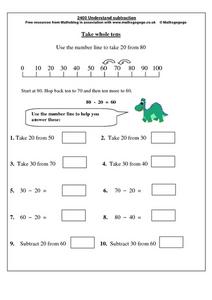Maths Blog
Equivalent Fractions: Equal, Largest, or Smallest
Elementary mathematicians begin by reading a one-page text that explains how to compare fractions. They solve two problems in which they must circle equal fractions in a set. They then solve four problems where a set of five fractions is...
Maths Blog
Understand Subtraction - Take Whole Tens
Use a number line to demonstrate subtracting by tens. Learners "hop" backwards down a tens number line to complete subtraction equations. Several different ways to express the operation are included.
Maths Blog
Adding/Subtracting Whole Numbers in Your Head
Exercise those mental math muscles! This worksheet contains 10 addition and 10 subtraction problems which require learners to compute sums or differences in their heads. A quick review at the top of the page provides a strategy based on...
Maths Blog
Make 20
There are quite a few ways to make the number 20 through addition. Learners fill in missing addends to reach the sum of 20 then answer additional related questions. This is a good resource because it has the class both add to 20 and...
Maths Blog
Decimal Fractions: Tenths
Reading tenths as phrases (such as three tenths, or five and nine tenths), forth graders write down both fractions and decimal equivalents. There are 10 problems on this page, making it a nifty pop quiz! Assess math learners grasp of...
Maths Blog
Count On Past 100 (Pg 2)
Your mathematicians are given a number at which to start and an amount to count on from there. They then record the number where they end. For example, "Count on 7 from 133." The answer is 140. There are 7 problems on this page. Answers...







